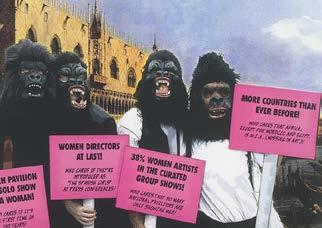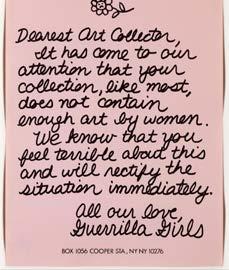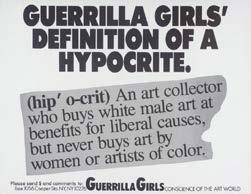
5 minute read
Artist Spotlight: Guerrilla Girls
from Unforeseen
Artist Spotlight: The Guerrilla Girls By Riddhi Kanetkar
The subjectivity of art lends itself the opportunity to exhibit a wide range of genders, cultures and movements in an equalising manner. Why then, has the art industry become so notorious for its lack of representative diversity in galleries, collections and auctions?
Advertisement
The Guerrilla Girls are an all-female group of artist activists who have aimed to redress this issue since the mid-1980s. Formed in New York City in 1985, the group are renowned for their efforts in raising awareness about sexism and racism in the art world. They also sport gorilla masks and the names of deceased female artists, because they believe that the movement is bigger than their individual identities. From producing posters, billboards and even stickers, not only have they sought to subvert the homogeneity of artists acquired by collectors, but also the style of art. Their core aims are:
Their art is notable for its deviation from traditional methods to more contemporary forms which utilise typography and writing. Although some have critiqued their seemingly plain stylistics, they have chosen to privilege a conceptual style of art, which places subject matter at the forefront of their artistic practices. We can see this resonate in the vast majority of their work, which is also often underscored by a message of feminist, political satire.
Photo: The Guerrilla Girls, via National Museum of Women in the Arts


Photos: The Guerrilla Girls, via Tate Modern Part of the ‘Feminism and Media’ selection at the Tate Modern, their work embodies a shift towards a politicised form of art. These posters challenge the unequal structures in the art world, which work to the detriment of women artists and artists of colour.

Their slogans are short and beguiling, prominently underlined by a tone of satire which critiques the white, male hegemony within the art industry.
The pink poster below is another parodical poster that takes on an epistolary format, and directly addresses art collectors for their androcentric art collections. While the pink background and cursive handwriting is a gesture to traditionally emphasised feminine aesthetics, they have mobilised on this visual by subverting it, to instead express a sardonic message.
This parodical poster particularly underlines the tongue-in-cheek tone that the Guerrilla Girls employ when calling out the asymmetrical practices in the industry. A shift from visual art to text-based content also destabilised the paradigms existing in the art industry, which was previously very visually, fine-art dominated. Their departure from these orthodox forms is a further testament to the way they have sought to modernise the way that art is portrayed.
The following billboard is another addressal to art collectors, but is more variegated in colour – presumably because they wanted a strong visual impact, as it would be displayed outside museums. This tackles the classist dimension of art collection, and highlights the parallels between art collectors and billionaires in propagating economic disparities. There is a strong political element that pervades through their work, because they have pushed art beyond its aesthetic category, and imbued their work with a strong egalitarian message.
Photo: The Guerrilla Girls, via JSTOR Daily

Why is their work so significant?
Conforming to many other sectors, the art industry has severely underrepresented both women and artists of colour – a predicament that has affected women artists of colour the most. Historically, there have been many exclusionary mechanisms in place that made it difficult for these groups to break into the industry.
In her essay ‘Why have there been no great women artists?’ the art theorist Linda Nochlin explains that women were prevented from entering art-guilds and academies which denied them the opportunity to create major artworks. Furthermore, prior to second-wave feminism, women were largely encouraged to occupy themselves with domestic tasks and motherhood, which dissuaded many from a professional career in art.
Similarly, racial inequality has been a defining factor in art galleries across the world. A study conducted by PLOS ONE in 2019 found that:
Underrepresenting artists of colour not only strips them of professional opportunities, but also diminishes the prospect of showcasing a wider cultural perspective that is equally enriching to society.
These statistics point to an enduring lacuna in representation in art galleries and collections across the world. While in recent years, female artists, LGBTQ+ artists and artists of colour have seen a steady rise in breakthroughs at auctions, there is still much work to be done. Art is an expression of identity. To deny that right to groups who are already marginalised is to erase their powerful stories from the mosaic of narratives currently occupying the art world.
In revolutionising existing artistic practices, as well as confronting archaic conventions and opinions, the Guerrilla Girls have politicised the plain – seeking out to transform the art world from its monolithic roots to a more kaleidoscopic institution.
Grater Expectations is a feminist zine under UCL’s investigative magazine The Cheese Grater.

Through exposé, poetry, art, and more, Grater Expectations aims to inform, entertain, and satisfy your appetite for feminism.
Send in your submissions or any questions for the next issue: zine@cheesegratermagazine.org
UCL Cheese Grater Magazine Society President—Rob Davidson president@cheesegratermagazine.org Editor-in-Chief—Sophia Robinson editor@cheesegratermagazine.org Investigations Editor—Riddhi Kanetkar investigations@cheesegratermagazine.org Humour Editor—Ella Ticktin-Smith humour@cheesegratermagazine.org Online Editor—Adam Bloss online@cheesegratermagazine.org Graphics Editor—Maryam Badghisi © Students’ Union UCL, 25 Gordon Street, London WC1H 0AY. Views expressed herein are not necessarily those of SU UCL or the editors.


